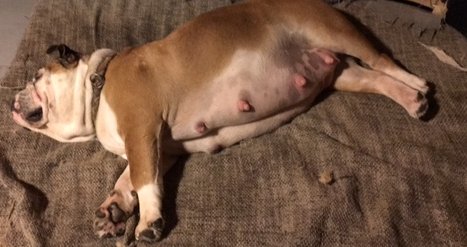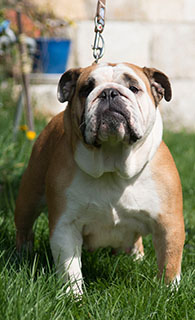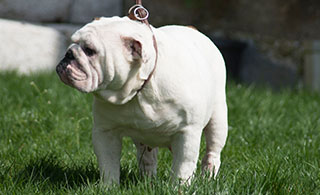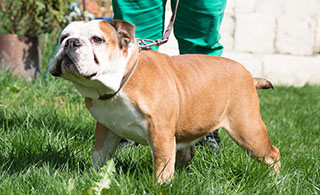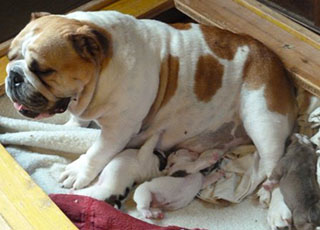Various issues are important during rearing and therefore must be followed
My breeding goals
- Straight tail
- Natural birth
Breed characteristics
Short-nosed (brachycephaly); see also https://en.wikipedia.org/wiki/Brachycephaly
One of the main characteristics of the English Bulldog is having a short nose (brachycephaly), not to be confused with the brachycephalic syndrome. Brachycephaly describes to head shape of short-nosed dog breeds. Not every short-nosed dog suffers from the brachycephalic syndrome, which also occurs in long-nosed dogs. Audible breathing and audible panting alone do not constitute this syndrome. The brachycephalic syndrome means shortness of breath, i.e. gasping for air, turning blue, pumping respiration in the loin area, and is often accompanied by a continually opened mouth with foam and partial collapse. In my opinion, such dogs should be euthanised. This syndrome, for the most part caused by exaggerated breed characteristics, can also be eliminated in purebred dogs through targeted selection of the breeding animals (see the head studies of ‘Zaaba’ and ‘Chianti’). Breathing is no longer audible in either of these two English Bulldogs. As a nice side effect, there are no longer any visible teeth because they have a somewhat longer nose and a moderate nasal fold.
From mating to birth
Pregnancy lasts approx. 9 weeks. The date of birth can be calculated in advance within +/- 2 days provided that the bitch has been mated only once (excluding surprises).
If the mating takes place on different days, the day of fertilisation can only be calculated afterwards (provided that the bitch gives birth naturally).
All of my bitches have so far had a drop in body temperature approx. 24 hours before the actual birth (temperature significantly below 37° Celsius). A prerequisite is that you quite accurately measure the body temperature every 8 hours (see attached temperature table).
My nerves are always on edge shortly before the birth. Nowadays I can control myself to the extent that I can suppress my internal tension, which is then not transferred to the bitch. This is far from easy. My dogs notice immediately when I am becoming nervous, and this nervousness is transferred to them 1 to 1 at lightning speed. A heavily pregnant bitch then begins to pant unnecessarily, and breeder and bitch wind each other up for so long until you run to the vet out of sheer panic, and a C-section becomes a done deal. To my knowledge, the vast majority of C-sections are generally planned in advance because the breeders are afraid that something could happen to their bitch or their pups. Furthermore, a C-section is performed very quickly (approx. 1 hour) and you know what you have, instead of measuring temperature for days and waiting patiently.
However, there is quite simply no emergency as long as the bitch is doing well and she is still eating and can sleep stretched out and relaxed, still wants to go for a walk, her temperature is within the normal range and the flews are pink inside.
Fortunately there are other breed club breeders who give the purebred bitch the opportunity to be able to give birth naturally:
- Ivo Beccarelli, Switzerland
- Bettina Selle-Treiber, Germany
- Sigrid Stauss, Switzerland
I would like to expand this list.
We also of course would never jeopardise the life of a bitch. Good reasons for a C-section are for example:
- One-pup litter: such a pup is normally too large for a natural birth
- Transverse position of a pup
- The birth has not started even 24 hours after the drop in temperature
Etc.
Preparing for birth
- Have available all the required utensils, such as dental floss, water and cloths for cleaning, scale etc.
- Two to three days before the expected date of birth, begin to measure temperatures every 8 hours. Almost exactly 24 hours before the beginning of birth, the temperature of the bitch drops to significantly below 37° Celsius.
Birth
The duration of the natural birth depends on the number of pups and the intervals between each delivery and can last up to 24 hours in dogs (compare approx. 1 hour for a C-section). A night shift is thus called for during a natural birth.
Furthermore, expectant mothers do not wish to have any visitors; often not even the other family members or employees should be present. The mothers only want to have me present, whom they can trust 100%. Maybe this is the reason why my pups are mainly born at night, when everyone else is sleeping.
Rearing
In the first weeks, the pups remain with the mother dog, who hardly leaves her pups during the first 14 days.
At around 10 days, the pups begin to open their eyes and at around 2 weeks they try to take their first steps. The first de-worming occurs at around 10 days. The pups get a little chopped meat from me for the first time when they can stand and totter around. It is very easy to overfeed heavy breeds, which in my experience can lead to the so-called swimmer puppy syndrome or to the fact that the pups are still not on their feet at 4 weeks. Correct feeding requires discipline from the breeder. Keeping a weight table from the first day is essential.
Starting with the fifth week, the pups will want to play outside and romp around (in winter, this starts with the sixth week at the earliest). The mother teaches the pups a lot but now also wants her rest now and then.
Starting with the ninth week, the mother takes care of her wild ones only very little. It is now our job to impart impressions to the pups (first contacts with the other dogs in the house, learning to wear a collar and take brief walks, riding in the car, visit to the veterinarian for vaccinations and implanting the microchip). Beginning with the 11th week of life, the pups are ready to be discharged, and saying farewell can sometimes be difficult.



